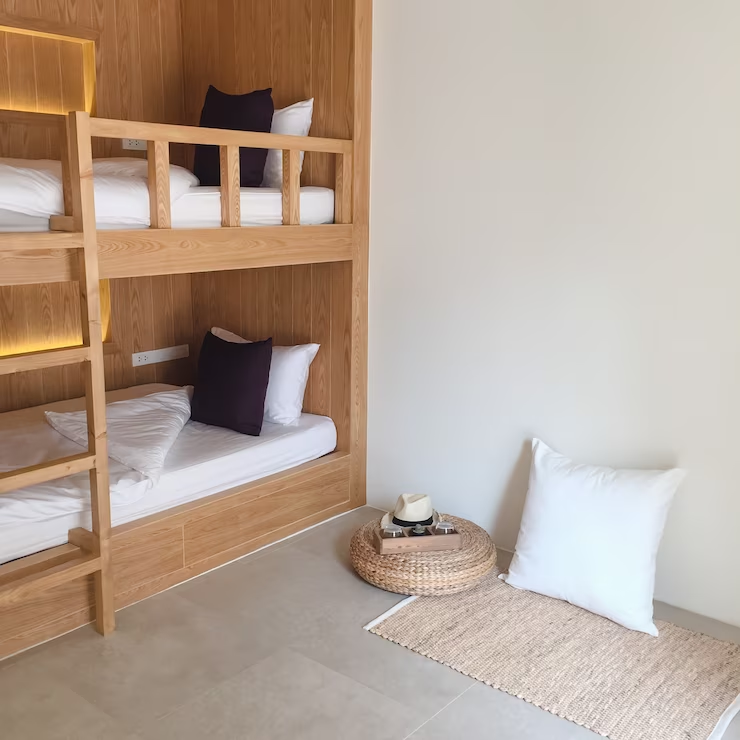Â
Â
Bunk beds have long been a practical choice for families looking to save space while adding a touch of fun to their homes. However, before deciding to purchase one, it’s essential to carefully consider both the pros and cons of bunk beds to ensure they meet your family’s specific needs. In this comprehensive guide, we’ll explore the various advantages and disadvantages of bunk beds, helping you make an informed decision that suits your lifestyle.

Â
The Advantages of Bunk Beds:
  1. Space-Saving Solution:
Bunk beds are an excellent way to maximize limited space in small bedrooms or shared spaces. By stacking the beds vertically, bunk beds free up valuable floor space, allowing for additional furniture or recreational areas. This makes them an ideal choice for families with multiple children, as well as those living in apartments or tiny homes with limited square footage.
Â
  2. Budget-Friendly Alternative:
Bunk beds offer a cost-effective way to accommodate multiple sleepers without needing to invest in additional beds. For families on a budget or those looking to furnish a guest room or vacation home, bunk beds are a more economical option compared to purchasing separate single beds for each child. This affordability factor makes bunk beds a practical choice for many households.
Â
 3. Fun and Engaging Design:
Bunk beds are not just functional—they bring a sense of excitement and imagination to any bedroom. Children, in particular, love the idea of sleeping in bunk beds, as it adds an element of adventure and fun to their daily routine. With a variety of designs available, including themed bunk beds featuring vibrant colors and built-in features like slides or tents, bunk beds can transform a simple bedroom into a playful retreat for kids.
 4. Versatility:
Bunk beds are incredibly versatile. Many models can be separated into two independent beds, offering flexibility as children grow or sleeping arrangements change. This adaptability ensures that bunk beds remain relevant over time, making them a smart long-term investment for families with growing children.
 5. Promotes Sibling Bonding:
Sleeping in close quarters can foster stronger bonds among siblings or roommates. The shared experience of bunk beds encourages communication, teamwork, and the development of social skills. Children often enjoy the camaraderie of having a “bunk bed buddy,†where they can share stories or secrets before drifting off to sleep. This shared experience strengthens sibling relationships and creates cherished memories.
Â
 6. Efficient Use of Vertical Space:
Bunk beds don’t just save floor space—they also make great use of vertical space, which is often underutilized in traditional bedroom layouts. By stacking beds vertically, bunk beds optimize the airspace above the floor, resulting in a more efficient and functional room design. This is especially beneficial in spaces with high ceilings or unconventional layouts where standard beds might not fit comfortably.
Â

Â
The Disadvantages of Bunk Beds:
 1. Safety Concerns:
While bunk beds can be fun and practical, safety must always be a priority. There is a risk that younger or restless children may fall from the top bunk due to its elevated position. To mitigate this risk, guardrails should be installed on all sides of the top bunk, and children should be taught proper safety guidelines when using bunk beds. Ensuring compliance with safety standards is crucial for minimizing accidents.
Â
 2. Limited Accessibility:
Reaching the top bunk can be challenging for young children or individuals with mobility issues. Climbing a ladder or set of stairs may pose a hazard, especially for those lacking the necessary coordination. Opting for bunk beds with built-in ladders or stairs can help address this issue, as they are easier to navigate and often include additional storage solutions.
Â
 3. Space Constraints:
Although bunk beds can save space in many scenarios, they may not be suitable for rooms with low ceilings or minimal vertical space. Before purchasing a bunk bed, it’s important to measure the ceiling height to ensure there is sufficient clearance to prevent injuries. Additionally, consider how the bunk bed will affect the room’s overall design and whether it will allow enough movement and circulation for daily activities.
 4. Design Limitations:
Despite the wide range of styles and designs available, customization options may be limited depending on the room’s decor. If a bunk bed design doesn’t align with the existing aesthetic, it might not blend seamlessly into the space. Furthermore, the type of bunk bed that can be installed may depend on the room’s dimensions and layout, which could restrict personalization choices.
Â
 5. Maintenance and Cleaning Challenges:
Maintaining and cleaning bunk beds can present challenges. Replacing sheets or making the bed on the top bunk can be difficult, potentially leading to hygiene concerns. Dust and debris may accumulate on the top bunk, requiring regular cleaning to maintain a healthy sleeping environment. Parents should take these practical considerations into account when selecting a bunk bed, ensuring it aligns with their lifestyle and maintenance preferences.
Â
Conclusion:
In summary, bunk beds offer numerous benefits, including their cost-effectiveness, adaptability, and space-saving design. However, it’s important to weigh these advantages against potential downsides, such as safety risks and accessibility limitations. By carefully evaluating the pros and cons, you can choose a bunk bed that meets your family’s needs and preferences. Explore Furnisco’s collection of bunk beds online to find the perfect combination of style, functionality, and quality for your home.
Â
Children's Holiday Balloons,Head Decoration Balloons,Party Theme Balloons
Xiongxian Tonghai Latex Products Co., Ltd , https://www.balloontonghai.com